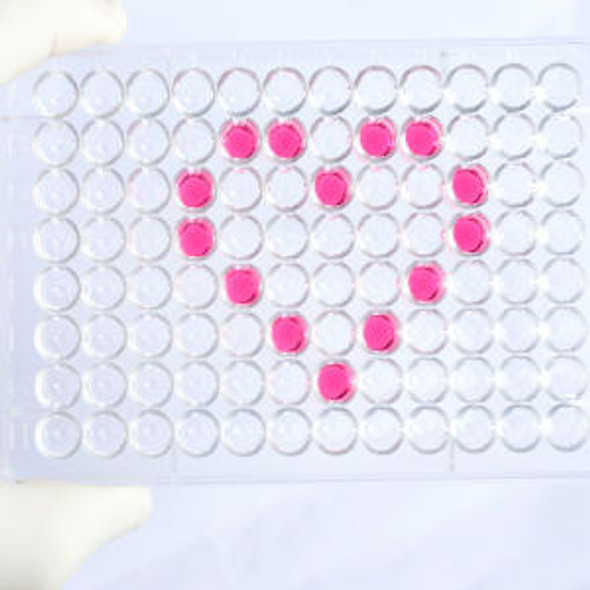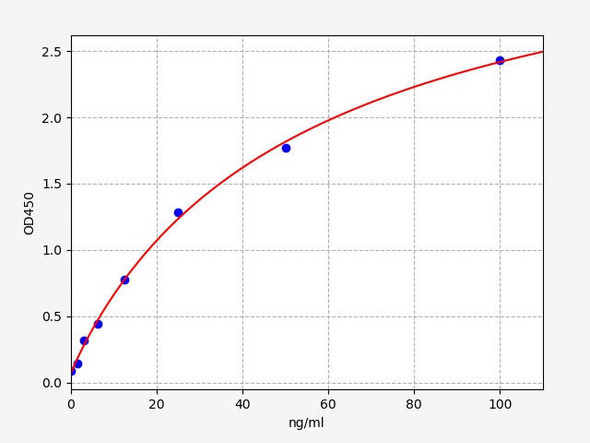Human Immunology ELISA Kits 1
Human ANXA2 (Annexin A2) ELISA Kit (HUES01659)
- SKU:
- HUES01659
- Product Type:
- ELISA Kit
- Size:
- 96 Assays
- Uniprot:
- P07355
- Sensitivity:
- 0.38ng/mL
- Range:
- 0.63-40ng/mL
- ELISA Type:
- Sandwich
- Synonyms:
- Annexin II, ANX2, ANX2L4, CAL1H, LIP2, LPC2, LPC2D, P36, PAP-IV
- Reactivity:
- Human
- Sample Type:
- Serum, plasma and other biological fluids
- Research Area:
- Immunology
Description
| Assay type: | Sandwich |
| Format: | 96T |
| Assay time: | 4.5h |
| Reactivity: | Human |
| Detection Method: | Colormetric |
| Detection Range: | 0.63-40 ng/mL |
| Sensitivity: | 0.38 ng/mL |
| Sample Volume Required Per Well: | 100µL |
| Sample Type: | Serum, plasma and other biological fluids |
| Specificity: | This kit recognizes Human ANXA2 in samples. No significant cross-reactivity or interference between Human ANXA2 and analogues was observed. |
This ELISA kit uses Sandwich-ELISA as the method. The micro ELISA plate provided in this kit has been pre-coated with an antibody specific to Human ANXA2. Standards or samples are added to the appropriate micro ELISA plate wells and combined with the specific antibody. Then a biotinylated detection antibody specific for Human ANXA2 and Avidin-Horseradish Peroxidase (HRP) conjugate are added to each micro plate well successively and incubated. Free components are washed away. The substrate solution is added to each well. Only those wells that contain Human ANXA2, biotinylated detection antibody and Avidin-HRP conjugate will appear blue in color. The enzyme-substrate reaction is terminated by adding Stop Solution and the color turns yellow. The optical density (OD) is measured spectrophotometrically at a wavelength of 450 nm ± 2 nm. The OD value is proportional to the concentration of Human ANXA2. The concentration of Human ANXA2 in samples can be calculated by comparing the OD of the samples to the standard curve.
| UniProt Protein Function: | ANXA2: a calcium-regulated membrane-binding protein whose affinity for calcium is greatly enhanced by anionic phospholipids. It binds two calcium ions with high affinity. Heterotetramer containing 2 light chains of S100A10 2 heavy chains of ANXA2. May cross-link plasma membrane phospholipids with actin and the cytoskeleton and be involved with exocytosis. Annexins are a family of structurally related proteins whose common property is calcium-dependent binding to phospholipids. There are at least ten different annexins in mammalian species. Annexins do not contain signal peptides, yet some annexins (A1, A2 and A5) appear to be secreted in a physiologically regulated fashion. |
| UniProt Protein Details: | Protein type:Motility/polarity/chemotaxis; Calcium-binding; Lipid-binding Chromosomal Location of Human Ortholog: 15q22. 2 Cellular Component: extrinsic to plasma membrane; extracellular space; cell surface; protein complex; lysosomal membrane; late endosome membrane; early endosome; lipid particle; cell cortex; lipid raft; ruffle; extracellular matrix; membrane; perinuclear region of cytoplasm; plasma membrane; melanosome; basement membrane; midbody; nucleus; sarcolemma; vesicle; endosome Molecular Function:protein binding; phosphatidylinositol-4,5-bisphosphate binding; calcium-dependent phospholipid binding; phospholipase A2 inhibitor activity; cytoskeletal protein binding; calcium ion binding; calcium-dependent protein binding; Rab GTPase binding Biological Process: fibrinolysis; positive regulation of fibroblast proliferation; collagen fibril organization; negative regulation of catalytic activity; positive regulation of vesicle fusion; protein heterotetramerization; positive regulation of binding; positive regulation of protein amino acid phosphorylation; angiogenesis; lipid raft formation; body fluid secretion; membrane budding |
| NCBI Summary: | This gene encodes a member of the annexin family. Members of this calcium-dependent phospholipid-binding protein family play a role in the regulation of cellular growth and in signal transduction pathways. This protein functions as an autocrine factor which heightens osteoclast formation and bone resorption. This gene has three pseudogenes located on chromosomes 4, 9 and 10, respectively. Multiple alternatively spliced transcript variants encoding different isoforms have been found for this gene. [provided by RefSeq, Jul 2008] |
| UniProt Code: | P07355 |
| NCBI GenInfo Identifier: | 113950 |
| NCBI Gene ID: | 302 |
| NCBI Accession: | P07355. 2 |
| UniProt Secondary Accession: | P07355,Q567R4, Q6N0B3, Q8TBV2, Q96DD5, Q9UDH8, |
| UniProt Related Accession: | P07355 |
| Molecular Weight: | 40,411 Da |
| NCBI Full Name: | Annexin A2 |
| NCBI Synonym Full Names: | annexin A2 |
| NCBI Official Symbol: | ANXA2 |
| NCBI Official Synonym Symbols: | P36; ANX2; LIP2; LPC2; CAL1H; LPC2D; ANX2L4; PAP-IV; HEL-S-270 |
| NCBI Protein Information: | annexin A2; annexin-2; protein I; annexin II; lipocortin II; chromobindin 8; chromobindin-8; calpactin I heavy chain; calpactin-1 heavy chain; calpactin I heavy polypeptide; placental anticoagulant protein IV; epididymis secretory protein Li 270 |
| UniProt Protein Name: | Annexin A2 |
| UniProt Synonym Protein Names: | Annexin II; Annexin-2; Calpactin I heavy chain; Calpactin-1 heavy chain; Chromobindin-8; Lipocortin II; Placental anticoagulant protein IV; PAP-IV; Protein I; p36 |
| Protein Family: | Annexin |
| UniProt Gene Name: | ANXA2 |
| UniProt Entry Name: | ANXA2_HUMAN |
As the OD values of the standard curve may vary according to the conditions of the actual assay performance (e. g. operator, pipetting technique, washing technique or temperature effects), the operator should establish a standard curve for each test. Typical standard curve and data is provided below for reference only.
| Concentration (ng/mL) | O.D | Average | Corrected |
| 40 | 2.343 2.371 | 2.357 | 2.294 |
| 20 | 1.637 1.657 | 1.647 | 1.584 |
| 10 | 0.964 0.924 | 0.944 | 0.881 |
| 5 | 0.416 0.44 | 0.428 | 0.365 |
| 2.5 | 0.275 0.249 | 0.262 | 0.199 |
| 1.25 | 0.17 0.156 | 0.163 | 0.1 |
| 0.63 | 0.11 0.12 | 0.115 | 0.052 |
| 0 | 0.058 0.068 | 0.063 | -- |
Precision
Intra-assay Precision (Precision within an assay): 3 samples with low, mid range and high level Human ANXA2 were tested 20 times on one plate, respectively.
Inter-assay Precision (Precision between assays): 3 samples with low, mid range and high level Human ANXA2 were tested on 3 different plates, 20 replicates in each plate.
| Intra-assay Precision | Inter-assay Precision | |||||
| Sample | 1 | 2 | 3 | 1 | 2 | 3 |
| n | 20 | 20 | 20 | 20 | 20 | 20 |
| Mean (ng/mL) | 2.02 | 3.69 | 18.13 | 1.96 | 3.63 | 18.51 |
| Standard deviation | 0.14 | 0.20 | 0.94 | 0.14 | 0.16 | 0.78 |
| C V (%) | 6.93 | 5.42 | 5.18 | 7.14 | 4.41 | 4.21 |
Recovery
The recovery of Human ANXA2 spiked at three different levels in samples throughout the range of the assay was evaluated in various matrices.
| Sample Type | Range (%) | Average Recovery (%) |
| Serum (n=5) | 88-102 | 94 |
| EDTA plasma (n=5) | 93-108 | 99 |
| Cell culture media (n=5) | 92-107 | 98 |
Linearity
Samples were spiked with high concentrations of Human ANXA2 and diluted with Reference Standard & Sample Diluent to produce samples with values within the range of the assay.
| Serum (n=5) | EDTA plasma (n=5) | Cell culture media (n=5) | ||
| 1:2 | Range (%) | 95-109 | 89-105 | 93-106 |
| Average (%) | 102 | 97 | 100 | |
| 1:4 | Range (%) | 93-109 | 82-95 | 82-93 |
| Average (%) | 100 | 88 | 88 | |
| 1:8 | Range (%) | 92-103 | 86-96 | 88-99 |
| Average (%) | 97 | 91 | 93 | |
| 1:16 | Range (%) | 91-103 | 85-100 | 81-91 |
| Average (%) | 98 | 92 | 87 |
An unopened kit can be stored at 4°C for 1 month. If the kit is not used within 1 month, store the items separately according to the following conditions once the kit is received.
| Item | Specifications | Storage |
| Micro ELISA Plate(Dismountable) | 8 wells ×12 strips | -20°C, 6 months |
| Reference Standard | 2 vials | |
| Concentrated Biotinylated Detection Ab (100×) | 1 vial, 120 µL | |
| Concentrated HRP Conjugate (100×) | 1 vial, 120 µL | -20°C(shading light), 6 months |
| Reference Standard & Sample Diluent | 1 vial, 20 mL | 4°C, 6 months |
| Biotinylated Detection Ab Diluent | 1 vial, 14 mL | |
| HRP Conjugate Diluent | 1 vial, 14 mL | |
| Concentrated Wash Buffer (25×) | 1 vial, 30 mL | |
| Substrate Reagent | 1 vial, 10 mL | 4°C(shading light) |
| Stop Solution | 1 vial, 10 mL | 4°C |
| Plate Sealer | 5 pieces | |
| Product Description | 1 copy | |
| Certificate of Analysis | 1 copy |
- Set standard, test sample and control (zero) wells on the pre-coated plate and record theirpositions. It is recommended to measure each standard and sample in duplicate. Note: addall solutions to the bottom of the plate wells while avoiding contact with the well walls. Ensuresolutions do not foam when adding to the wells.
- Aliquot 100 µL of standard solutions into the standard wells.
- Add 100 µL of Sample / Standard dilution buffer into the control (zero) well.
- Add 100 µL of properly diluted sample (serum, plasma, tissue homogenates and otherbiological fluids) into test sample wells.
- Cover the plate with the sealer provided in the kit and incubate for 90 min at 37 °C.
- Aspirate the liquid from each well, do not wash. Immediately add 100 µL of BiotinylatedDetection Ab working solution to each well. Cover the plate with a plate seal and gently mix. Incubate for 1 hour at 37 °C.
- Aspirate or decant the solution from the plate and add 350 µL of wash buffer to each welland incubate for 1-2 minutes at room temperature. Aspirate the solution from each well andclap the plate on absorbent filter paper to dry. Repeat this process 3 times. Note: a microplatewasher can be used in this step and other wash steps.
- Add 100 µL of HRP Conjugate working solution to each well. Cover with a plate seal andincubate for 30 min at 37 °C.
- Aspirate or decant the solution from each well. Repeat the wash process for five times asconducted in step 7.
- Add 90 µL of Substrate Reagent to each well. Cover with a new plate seal and incubate forapproximately 15 min at 37 °C. Protect the plate from light. Note: the reaction time can beshortened or extended according to the actual color change, but not by more than 30min.
- Add 50 µL of Stop Solution to each well. Note: Adding the stop solution should be done inthe same order as the substrate solution.
- Determine the optical density (OD value) of each well immediately with a microplate readerset at 450 nm.






